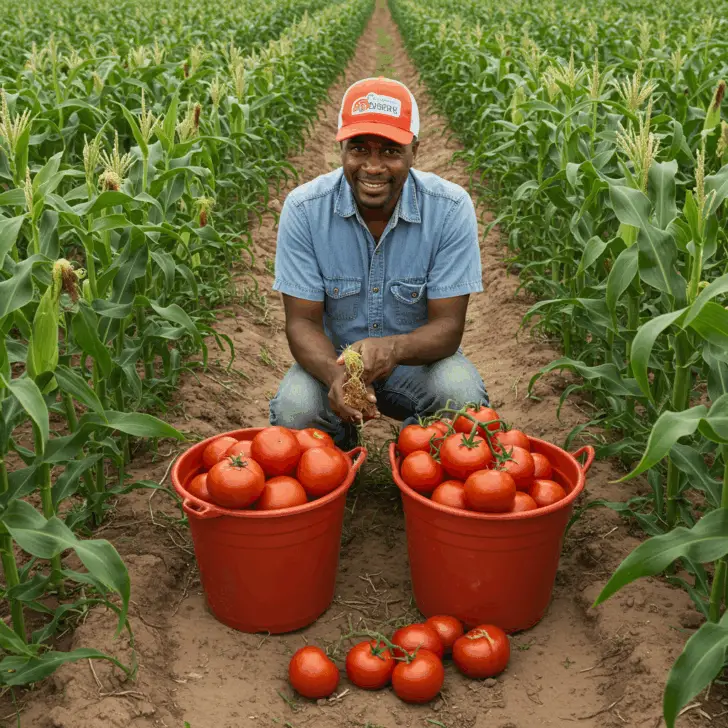Achieving a bountiful harvest of corn and tomatoes relies heavily on understanding the ideal planting distance for each crop. This comprehensive guide explores the optimal spacing requirements for corn and tomatoes, considering factors like variety, soil type, and supporting structures. Learn how proper spacing maximizes sunlight, airflow, nutrient uptake, and ultimately, your garden’s yield.

Introduction:
Corn and tomatoes are staples in many gardens, offering fresh, flavorful additions to summer meals. However, simply planting seeds or seedlings isn’t enough to guarantee success. One crucial element often overlooked is proper spacing. Overcrowding can lead to stunted growth, disease, and reduced yields, while spacing plants too far apart can waste valuable garden space. This guide dives into the ideal planting distances for both corn and tomatoes, helping you maximize your harvest potential.
JUMP TO TOPIC
Understanding Corn Spacing
Why Spacing Matters for Corn
Corn is a wind-pollinated crop, meaning it relies on the wind to carry pollen from the tassels to the silks of other corn plants. Insufficient spacing hinders proper pollination, leading to incompletely filled ears and reduced kernel development. Proper spacing also ensures each plant receives adequate sunlight, promotes air circulation (reducing fungal diseases), and allows for better nutrient uptake.
Recommended Corn Spacing
The general recommendation for corn spacing is to plant seeds 12-18 inches apart within rows that are 2-3 feet apart. However, specific varieties might have slightly different requirements, so always check the seed packet for specific instructions.
Spacing for Different Corn Varieties
Sweet Corn: Typically follows the 12-18 inch within-row spacing guideline.
Popcorn: Similar spacing to sweet corn, but some varieties may benefit from slightly wider spacing (up to 24 inches).
Flint Corn/Indian Corn: Often planted slightly closer together, around 10-12 inches, due to smaller plant size.
Considering Soil Type and Nutrients
Rich, well-drained soil can support slightly closer spacing, while poor soil may require wider spacing to account for reduced nutrient availability.
Optimizing Corn Planting Layout for Pollination
Planting corn in blocks, rather than long single rows, promotes better pollination, especially in smaller gardens. This block planting creates a higher density of plants, increasing the chance of successful wind pollination. Aim for blocks at least four rows wide.
Understanding Tomato Spacing
Why Spacing Matters for Tomatoes
Tomatoes, unlike corn, are self-pollinating. However, proper spacing remains crucial for several reasons:
Sunlight Penetration: Adequate spacing allows sunlight to reach all parts of the plant, promoting healthy growth and fruit ripening.
Air Circulation: Proper spacing minimizes humidity around the plants, reducing the risk of fungal diseases like early blight and late blight.
Nutrient Access: Spacing ensures each plant has access to sufficient nutrients and water from the soil.
Ease of Harvesting: Adequate space makes it easier to access and harvest ripe tomatoes.
Recommended Tomato Spacing
Tomato spacing varies significantly depending on the growth habit of the variety:
Determinate vs. Indeterminate Tomatoes
Determinate Tomatoes: These compact varieties grow to a certain height and then stop. They require less space and can be planted 18-24 inches apart.
Indeterminate Tomatoes: These varieties continue to grow and produce fruit throughout the season. They require more space and should be planted 24-36 inches apart.
Spacing Based on Support Structures
Staked Tomatoes: Staking allows for closer spacing, typically 18-24 inches apart. Check our guide on staking tomatoes (Example internal link – adapt as needed).
Caged Tomatoes: Caging requires slightly more space, generally 24-36 inches between cages.
Sprawling Tomatoes: Allowing tomatoes to sprawl on the ground requires the most space, 3-4 feet between plants.
Impact of Soil Quality on Tomato Spacing
Similar to corn, richer soils can support slightly closer spacing for tomatoes, while poor soils might necessitate wider spacing.
FAQs About Corn and Tomato Spacing
Q: Can I plant corn and tomatoes together?
A: Yes, you can! However, be mindful of their respective spacing needs and ensure neither plant shades the other. Taller corn can shade tomatoes, so consider planting them on the north side of the tomato plants. Learn more about companion planting with this helpful guide from the Old Farmer’s Almanac.
Q: What happens if I plant corn too close together?
A: Overcrowded corn plants will compete for resources, leading to stunted growth, reduced ear size, and increased susceptibility to disease.
Q: What happens if I plant tomatoes too close together?
A: Overcrowded tomatoes are more prone to fungal diseases due to reduced airflow. They may also produce smaller, fewer fruits.
Q: Can I adjust spacing based on my garden size?
A: While it’s best to follow recommended spacing guidelines, you can adjust slightly based on your garden’s limitations. However, prioritize proper spacing over squeezing in too many plants.
Q: How can I improve pollination in my corn patch?
A: Planting in blocks rather than rows significantly improves wind pollination. You can also hand-pollinate by collecting pollen from the tassels and dusting it onto the silks.
Conclusion
Proper spacing is a cornerstone of successful corn and tomato cultivation. By understanding the specific needs of each crop and implementing the recommended spacing guidelines, you can maximize your harvest potential and enjoy a bountiful supply of these garden favorites. Remember to consider factors like variety, soil type, and supporting structures when determining the optimal planting distance. Happy gardening!

